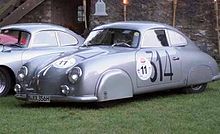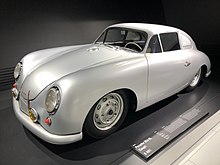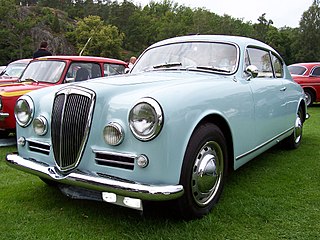| Year | Event | Date | Chassis | Engine | Starting number | Driver | Result |
|---|
| 1951 | Zandvoort | 09/06/1951 | 356/2-063 | 1086cc | 10 | G.F. Roeloffzen | Crashed on way back to Stuttgart |
| 24 Hours of Le Mans | 23/06/1951 | 356/2-056(063) | 1086cc | 46 | Auguste Veuillet / Edmond Mouche | 20th overall, winner under 1100cc class |
| 21/06/1951 | 356/2-054 | 1086cc | 47 | Rudolf Sauerwein / Robert Brunet | Crashed during practice |
| Liège–Rome–Liège | 15/08/1951 | 356/2-056(063) | 1086cc | 16 | Huschke von Hanstein / Petermax Muller | Tenth overall and second in the 1100cc class [5] |
| 356/2-055 | 1488cc | 33 | Paul von Guilleaume / Heinrich von der Muhle | Third overall and first in the 1500cc class [5] |
| Monthlery | 07/10/1951 | 356/2-056(063) | | 96 | | |
| 1952 | Rallye Paris – Saint-Raphaël Féminin | 27/02/1952 | 356/2-061(3004) | | 72 | Gilberte Thirion / Max Thirion | |
| Vero Beach 12 Hours | 08/03/1952 | 356/2-054(3001) | | 41 | Fritz Koster | 16th overall and 6th in class |
| 356/2-055(3003) | | 57 | Karl Brocken | 7th overall and first in class |
| 12h Sebring | 15/03/1952 | 356/2-054(3001) | | 31 | Fritz Koster | DNS |
| Wolverthem | 16/03/1952 | 356/2-061(3004) | | | Gilberte Thirion | 3th overall [12] |
| Palm Springs | 23/03/1952 | 356/2-056(3002) | | | John von Neumann | |
| Rallye International Lyon-Charbonnieres | 28/03/1952 | 356/2-061(3004) | | | Gilberte Thirion / Max Thirion | Retired |
| Rallye Soleil-Cannes | 06/04/1952 | 356/2-061(3004) | | 207 | Gilberte Thirion / Max Thirion | 5th overall |
| Pebble Beach | 20/04/1952 | 356/2-056(3002) | 1500cc | 40 | John von Neumann | 21st overall |
| 356/2-055(3003) | | | Karl Brocken | DNF |
| Mille Miglia | 04/05/1952 | 356/2-060 | 1500cc | 327 | Giovanni Lurani and Count Philipp Constantin von Berckheim | 46th overall and first under 1.5-litre GT car [5] |
| Grand Prix de Bordeaux | 04/05/1952 | 356/2-062 | 1500cc | 92 | Auguste Veuillet | Winner in class |
| Golden Gate | 05/05/1952 | 356/2-056(3002) | 1500cc | 11 | | |
| 12h Cassablanca | 16/05/1952 | 356/2-061(3004) | | | Gilberte Thirion / Germaine Rouault | DNF (gearbox) |
| Bridgerhampton Road Races | 24/05/1952 | 356/2-054(3001) | | 43 | Fritz Koster | 3th overall 1500cc behind Max Hoffman in a Glockler |
| 356/2-055(3003) | | 56 | Karl Brocken | DNF |
| Golden Gate | 31/05/1952 | 356/2-056(3002) | | 11 | John von Neumann | 16th |
| Bol D'or | 08/06/1952 | 156/2-060(063) | | 2 | André Le Jamtel | Crashed |
| 24 Hours of Le Mans | 14/06/1952 | 356/2-059(055) | 1488cc | 47 | Auguste Lachaize / Eugene Martin | disqualified during the 19th hour because the engine was left running during a pit stop |
| 356/2-062 | 1086cc | 50 | Auguste Veuillet / Edmond Mouche | 11th overall, winner under 1100cc class |
| 356/2-058 | 1086cc | 51 | Huschke von Hanstein / Petermax Muller | DNF (gearbox) |
| Tour de France | 19/06/1952 | 356/2-061(3004) | | 62 | Paul von Guillaume | |
| Rallye International des Alpes | 11/07/1952 | 356/2-061(3004) | | 136 | Gilberte Thirion / Max Thirion | retired |
| Torrey Pines | 20/07/1952 | 356/2-056(3002) | | 11 | John von Neumann | Winner under 1500cc class |
| Liège–Rome–Liège | 13/08/1952 | 356/2-059(055) | | 4 | Pierre Stasee / Hermand | |
| 356/2-062 | | 22 | Gianni Lurani & Wilhelm Hild | |
| 356/2-058 | | 30 | Huschke von Hanstein / Petermax Muller | 10th overall and 7th under 1500cc class |
| 356/2-061(3004) | | 81 | Helmut Polensky / Walter Schluter | Winner overall |
| Thompson Raceway | 17/08/1952 | 356/2-054(3001) | | | Fritz Koster | Winner in under 1500cc class |
| Stella Alpina Rally | 28/08/1952 | 356/2-052 | | 194 | Otto Mathé | |
| Allentown, Pennsylvania | 03/09/1952 | 356/2-054(3001) | | 53 | Fritz Koster | 4th overall |
| Coppa Inter Europa | 07/09/1952 | 356/2-058 | | 34 | Giovanni Lurani | 1st in under 1500cc class |
| Elkhard Lake | 07/09/1952 | 356/2-056(3002) | | 11 | John von Neumann | 3th overall |
| 356/2-055(3003) | | 117 | Karl Brocken | 2nd overall |
| Tour de France Automobile | 16/09/1952 | 356/2-061(3004) | | 62 | Gilberte Thirion / Ingeborg Polensky | Excluded |
| Watkins Glen | 20/09/1952 | 356/2-054(3001) | | 76 | Fritz Koster | 6th overall |
| Tour de Belgique | 25/10/1952 | 356/2-061(3004) | | 165 | Gilberte Thirion / Max Thirion | 5th in class III |
| 4h Turner | 26/10/1952 | 356/2-055(3003) | | 74 | Ed Trego | DNF |
| Madera Airport | 09/11/1952 | 356/2-056(3002) | | | John von Neumann | Overall winner |
| Torrey Pines | 14/12/1952 | 356/2-056(3002) | | | John von Neumann | Overall winner |
| 1953 | Rallye Paris - Saint-Raphaël Féminin | 18/02/1953 | 356/2-061(3004) | | 66 | Gilberte Thirion | Accident |
| Rallye Sestriere | 26/02/1952 | 352/2-062 | | 72 | Bracco Giovanni / Fritz 'Huschke' von Hanstein | |
| Palm Springs Road Races | 22/03/1953 | 356/2-056(3002) | | 11 | John von Neumann | Overall Winner |
| | Josie von Neumann | 3th overall |
| Internationale Tulpenrallye | 26/04/1953 | 356/2-061(3004) | | | Gilberte Thirion / Ingeborg Polensky | Retired |
| International Trophy Silverstone | 09/05/1953 | 356/2-062 | | 6 | | |
| 24 Hours of Le Mans | 12/06/1953 | 356/2-062 | 1091cc | 46 | Gonzague Olivier / Eugene Martin | DNF (Engine failure) |
| 356/2-051(058) | 1091cc | 49 | Auguste Veuillet / Petermax Muller | DNF (Engine failure) |
| Bridgerhampton | 23/05/1953 | 356/2-054(3001) | | 89 | Al Koster | |
| Stockton | 28/06/1953 | 356/2-056(3002) | | | John von Neumann | |
| Rallye des Alpes | 10/07/1953 | 356/2-061(3004) | | 309 | Gilberte Thirion / Renaud Lise | 44th overall, 3th ladies, 6th in under 1600cc |
| Chino | 19/07/1953 | 356/2-056(3002) | | | John von Neumann | 2nd overall |
| Liège–Rome–Liège | 19/08/1953 | 356/2-051(058) | | 50 | Müller / Schellhaas | 13th overall |
| 356/2-059(055) | | 84 | | |
| 356/2-062 | | | | |
| Belgrado | 10/09/1953 | 356/2-062 | | | Fritz 'Huschke' von Hanstein | |
| Tour de France Automobile | 13/09/1953 | 356/2-061(3004) | | 27 | Gilberte Thirion / Ingeborg Polensky | Retired |
| Madera Airport | 20/09/1953 | 356/2-056(3002) | | 11 | John von Neumann | 2nd overall |
| Rallye Internacional de Lisboa, Estoril | 13/10/1953 | 356/2-059(055) | | 15 | Helmut Polensky / Walter Schluter | 3th overall |
| 2.5h Reno | 18/10/1953 | 356/2-056(3002) | | 11 | John von Neumann | 7th overall |
| Tour de Belgique | 24/10/1953 | 356/2-061(3004) | | | Gilberte Thirion / Gonzague Olivier | Overall Winner |
| Internationale Rallye du Maroc | 02/11/1953 | 356/2-061(3004) | | 308 | Gilberte Thirion / Renaud Lise | 8th overall |
| March AFB | 08/11/1953 | 356/2-056(3002) | | | John von Neumann | 3th overall |
| Carrera Panamericana | 19/11/1953 | 356/2-062 | | 153 | Guillermo Suhr Contreras / Oscar Alfonso | |
| 356/2-054(3001) | | 199 | Joaquin Castillo de la Fuente | |
| 1954 | Randonnée des Routes Blanches | 13/02/1954 | 356/2-061(3004) | | 38 | Gilberte Thirion / Washer Nadège | 6th overall |
| Rallye Paris - Saint-Raphaël Féminin | 03/03/1954 | 356/2-061(3004) | | 96 | Gilberte Thirion | 3th overall |
| 12 Heures de Huy | 04/04/1954 | 356/2-061(3004) | | | Gilberte Thirion | Overall Winner |
| Rallye Soleil-Cannes | 10/04/1954 | 356/2-061(3004) | | | Gilberte Thirion / Washer Nadège | 4th overall |
| Andrews AFB | 02/05/1954 | 356/2-054(3001) | | | Al Koster | |
| Lockbourne AFB | 08/08/1954 | 356/2-055(3003) | | 112 | Lloyd Barton | |
| Liège–Rome–Liège | 18/08/1954 | 356/2-059(055) | 1500cc | 86 | Helmut Polensky / Herbet Linge | Winner |
| Tour de France Automobile | 12/09/1954 | 356/2-061(3004) | | 229 | Gilberte Thirion / Ingeborg Polensky | 5th overall and 2nd in class S |
| Tour de Belgique | 23/10/1954 | 356/2-061(3004) | | 39 | Gilberte Thirion / Ingeborg Polensky | 9th overall, 3th in class III |
| Carrera Panamericana | 13/11/1954 | 356/2-054(3001) | | 100 | Jacqueline Evans de López | DNF (Gearbox) |
| Rallye du Maroc | 13/12/1954 | 356/2-061(3004) | | 214 | Gilberte Thirion / Renaud Lise | 23th overall |
| 1955 | 12Hrs Sebring | 13/03/1955 | 356/2-051(058) | 1488cc | 69 | Guy Atkins / Traver McKenna | 34th overall |
| Lawrenceville Airport | 19/06/1955 | 356/2-055(3003) | | 111 | Warren Steele | 3th overall |
| Liège–Rome–Liège | 15/08/1955 | 356/2-059(055) | | 128 | Helmut Polensky / Herbert Linge | retired |
| Coppa Inter Europa | 11/09/1955 | 356/2-059(055) | | 6 | Richard von Frankenberg | |
| 1956 | Santa Ana, El Salvador | 25/11/1956 | 356/2-062 | | | Guillermo Suhr | |
| 1957 | San Benito, El Salvador | 31/03/1957 | 356/2-062 | | | Wenseslao Garcia | |
| Road America | 07/09/1957 | 356/2-057 | | 23 | Carl Schmidt | |

















